
The 60th anniversary of the Frecce Tricolori
Report and photos by Gabriele Rivera
November 24, 2021
Sixty years is an age that can push lots of people to start thinking about retirement; this is not true for the Italian Air Force aerobatic team, the Frecce Tricolori, which has just celebrated this important milestone with a mindset bound to the future, not forgetting their roots.
The Frecce Tricolori are based in Rivolto, near Udine, less than 100 km (60 miles) from the eastern border of Italy. That area can be considered the cradle of the Italian tradition of aerobatics: in the late 1920s the nearby airfield of Campoformido was witness to the first introduction of aerobatics manouvers in the training of the fighter pilots, an idea launched by Rino Corso Fougier, the commander of the 1° Stormo Caccia (1st Fighter Wing). In a few years the aerobatic exhibitions of Italian pilots became very popular in Italy and abroad.
Interrupted by WWII, this tradition was resumed in 1952, when the pilots of the 4° Stormo (4th Wing), then based in Capodichino (near Naples), decided to form with their De Havilland Vampires the “Cavallino Rampante” team. The next step was a sort of shift among several Stormi (Wings); each year a different Stormo Caccia provided pilots and planes (first F-84F Thunderstreak and then F-86E Sabre) to form an aerobatic team, adopting their own colours and insignia. On March 3rd, 1961, six 4° Stormo’s pilots moved to Rivolto with their Sabres to form a dedicated team, starting to be known as the Pattuglia Acrobatica Nazionale (National Aerobatic Patrol); two months later the team received the official designation of 313° Gruppo Addestramento Acrobatico (313rd Aerobatic Training Group).
To summarize sixty years and more of history of Italian aerobatics the aircraft the Frecce fly on have seen their tails repainted with five different schemas, each one paying homage to the teams that during the ‘50s took alternatively charge of the task of performing their programs of aerobatics manouvers to the public in the airshows of those days: Cavallino Rampante (Prancing Horse), Getti Tonanti (Thundering Jets), Tigri Bianche (White Tigers), Diavoli Rossi (Red Devils), Lancieri Neri (Black Lancers). The names of these ancestor teams have been written along the airframe of every Aermacchi MB339 PAN, also known as Pony (the callsign adopted by the Frecce).

Truth to be told, the tails have not been repainted: adhesive films have been developed in order to cover entirely the tail and endure the stress undergone during the manouvers. “Pony 0”, the aircraft of the Frecce’s Commander, Lt. Col. Gaetano Farina, sports another emblema, the one created for the celebration, representing a number 60 cut in halves, topped by the classical logo of the Frecce releasing the three colors of the Italian flag.
Also if the anniversary falls on March, traditionally the Frecce postpone the event till September, often closing the summer season of exhibitions along the Italian peninsula and abroad with a big airshow. After eighteen months of pandemic emergency launching such a major event has not been an easy task; the usual attendance can hit four hundred thousand people, while the COVID rules adopted this year have strictly limited the affluence. A booking website has been set up in order to obtain a reservation for Saturday 18th or Sunday 19th, as well as for Friday 17th, reserved to the spotters. The seats (yes, this has been a theatre-like event) have gone sold-out in a few hours, letting eight thousand people per day to attend such a long awaited airshow (last one launched for an anniversary was in 2015), and to enter in Rivolto airbase you have to exhibit your Green Pass.
The weather forecast, just a few days before, were really threatening to rain cats and dogs, but the passing front pardoned the organizers, already dispelling the clouds on Friday afternoon and letting the sun shine on the airfield on Saturday. Only on Sunday did the rain gods exact their toll on the public and the airplanes but, as always, the show has gone on. The sudden change of weather has imposed a condition, the constant presence of swarms of gnats, which often stationed in front of the cameras, ruining dozens of pictures.
APD was in Rivolto on Saturday; gate were open at 10, while the dynamic displays were scheduled to start two hours later. As always an asset of almost any kind constituting the inventory of the Italian Air Force was on static display in a dedicated area; every aircraft displayed has had her share of photographers but surely special attention has been paid to the 32nd Stormo’s F-35A and the 14th Stormo’s G-550 CAEW (Conformal Airborne Early Warning).


Another reason to gather was the Pagani Automobili’s exhibit; Horacio Pagani, born in Argentina, is a supercar manufacturer based in Emilia Romagna (an Italian region where you can find Ferrari, Lamborghini and other dream car makers), and ten years ago he has dedicated one of his wonderful models, the Zonda Tricolore, to the 50th anniversary of the Frecce. For this event he has launched another dedicated car, the Huayra Tricolore; only three will be built, to be sold at 7,7 million dollars.

For their anniversary the Frecce arrange also an Aerobatic Teams Meeting; this one was the 12nd and those which has accepted the invitation were the Orlik Team (Poland), Patrulla Aguila (Spain), Midnight Hawks (Finland), and the Patrouille Suisse (Switzerland). The program included also the Red Arrows (United Kingdom), the Red Devils (Belgium), and the Krila Oluje (Croatia), but for different reasons they had to cancel their partecipation.




A few minutes after twelve o’clock the Orlik Team had the honour to open the airshow, just after the flyby of a 15° Stormo’s HH-139A showing the Italian flag. The Polish team, formed in 1998, use the PZL-130 Orlik TC-I, a turboprop two-seat trainer built in Poland; five of them have taken to the sky accompanied by the report of their speaker who has explained their manouvers in a good Italian. The team members are volunteers from 42nd Training Air Base in Radom-Sadkow Air Base and, thanks to the 340 mph airspeed they can reach, they perform an interesting set of manouvers.


The next team to display has been the Midnight Hawks, the aerobatic team of the Suomen Ilmavoimat (Finnish Air Force). Formed in 1997, the team flies with four BAe Hawk Mk.51; the pilots, whose callsign is quite obviously Midnite, are all qualified air combat instructors at the Air Force Academy. This season’s routine is divided roughly into two parts, the first of which showcases close formation flying. Their tight diamond formation is their signature, but they have introduced more vertical manouvers in the program to make it more breathtaking than before. In the routine the Midnight Hawks fly at its lowest a mere 300 feets above the ground with aircraft speed varying between 120-500 mph.


The Spanish team, Patrulla Aguila, born in 1985, has flown over 25,000 hours on the CASA C-101, designated E-25 Mirlo (Blackbird) in the Ejército del Aire (Spanish Air Force). The Patrulla is composed of seven aircraft, and the pilots are instructors assigned to the 793 escuadrón de la Academia General del Aire (793th Squadron, Air Academy). One of the features of the team is the use of yellow smokes (actually they should be the only ones to do so), being one of the two colours of the national flag, and their performance are accompanied by the typical whine of the Garrett TFE-731 and the exuberant description of their manouvers delivered by their commentator.


The Patrouille Suisse has closed the morning session of the schedule; formed in 1964, the Patrouille has flown for thirty years on the Hawker Hunter Mk 58, originally with four planes, which became six on 1978. The F-5E Tiger II replaced the Hunter in 1995, bringing the Patrouille in a new dimension, assured by the performance of a supersonic aircraft, the reason why their exhibitions are always very appreciated. The story about the mascot flying with them since 2000 is an interesting one: Flat Eric is a puppet which has been the main character of a Levi’s commercial, and you can spot him during the taxiing, handheld from one of the pilots. Quite surprinsigly, it wears a Red Arrows flightsuit; in 2004 it has been kidnapped by the British team, and after its reappearance the following year, the new outfit has been left unchanged. There is also a dedicated manouver in the Patrouille’s repertory, the “Flat Mirror”, performed by the two team solos. Needless to say, Flati (as is called by the team) has its flight log book!


After a short break the airshow resumed with another pass of the HH-139A showing the flag; the choice to broadcast this second part of the airshow, so understandable in itself, has been a calamity for us photographers, because in the afternoon the light on the runway worsens for the pictures.

Just before the flag pass, nine different aircraft have taken off, preparing to assemble as the Legend formation, composed of the aircraft that have been used as trainers in the Italian Air Force since 1949; the North American T-6G Texan, the FIAT G.46-4B, the SIAI-Marchetti SF.260AM and the Aermacchi MB-326E are privately owned, while Aeronautica Militare (the Italian Air Force) contributes with SIAI-Marchetti S.208M (with a special tail celebrating the centenary of the Rome-Tokyo expedition and Arturo Ferrarin, the Italian pilot who made it), Aermacchi MB-339A, MB-339CD and Leonardo T-346, all assets currently used by the operative training squadrons. On this occasion the formation has been incremented by another Aermacchi, a MB-326K, which like her orange sister, has been brought back to airworthy condition by Renzo Catellani, founder of Volafenice Flying Museum. Keep an eye on this wonderful enterprise, because in the next few years other surprises are in store for us enthusiasts! Without fear of contradiction I can say that the MB-326K, with her camo, has been one of the highlights of the event, highly anticipated by the amateurs waiting to record her flight into their cards.






 While the Legend formation was taxiing after the landing, two Typhoons of the 51st Stormo (temporarily based in Rivolto because their base, Istrana, is closed for runway works) have taken off simulating a scramble, in order to intercept a slow mover, a role played by the HH-139A. Circling around the helicopter, the Typhoons have forced the possible menace to land , fulfilling their mission and landing just a few minutes before the arrival of a special guest, Sergio Mattarella, President of the Italian Republic. His flight, an Airbus A319CJ of the 31st Stormo based in Ciampino (Rome), has been escorted by two Typhoons, and after the landing, a motorcade has brought the President to the official grandstand.
While the Legend formation was taxiing after the landing, two Typhoons of the 51st Stormo (temporarily based in Rivolto because their base, Istrana, is closed for runway works) have taken off simulating a scramble, in order to intercept a slow mover, a role played by the HH-139A. Circling around the helicopter, the Typhoons have forced the possible menace to land , fulfilling their mission and landing just a few minutes before the arrival of a special guest, Sergio Mattarella, President of the Italian Republic. His flight, an Airbus A319CJ of the 31st Stormo based in Ciampino (Rome), has been escorted by two Typhoons, and after the landing, a motorcade has brought the President to the official grandstand.



Following the President’s arrival, the airshow has entered its final leg, although a long one. The Reparto Sperimentale Volo (Test Flight Squadron), known as the “Spera”, has brought three demo aircraft, the C-27J Spartan, the T-346 Master and the F-2000 Typhoon. The performances of the two jets are impressive, but that’s something that you already expect to see; what is really always surprising, also if already seen several times, is the maneuverability of the Spartan, whose looping and tactical landing never fail to impress the public.
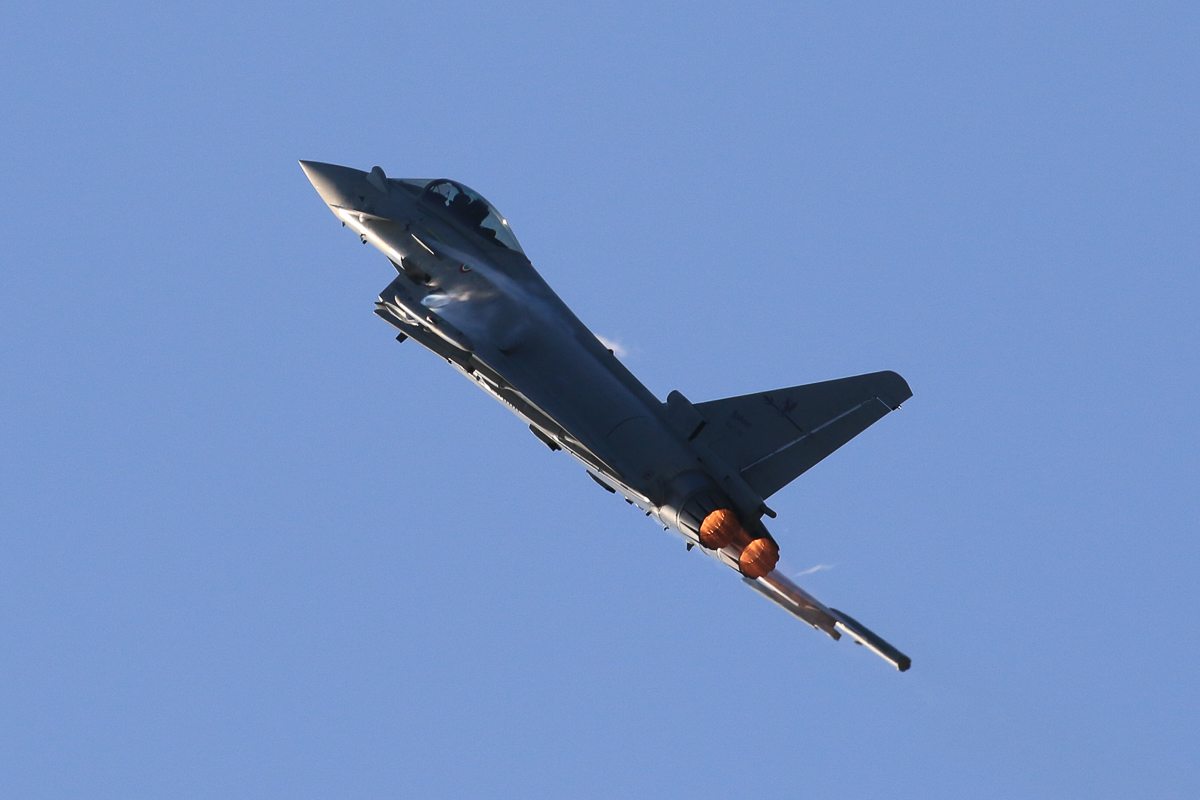

 After the Spera’s three-pronged dynamic display, the ItAF had scheduled an event to demonstrate the capabilities to conduct complex air-land operations. The first part has been an exfiltration simulation; a Lockheed C-130J of the 46th Aerobrigata (Air Brigade) has landed, opened the ramp, hypothetically embarked the civilian and military to exfiltrate, closed the ramp and taken off, all in four minutes and with the support of the Fucilieri dell’Aria (Air Fusiliers) of the 9th Stormo. This has been followed by a couple of very low altitude overflights performed by a KC-767A of the 14th Stormo.
After the Spera’s three-pronged dynamic display, the ItAF had scheduled an event to demonstrate the capabilities to conduct complex air-land operations. The first part has been an exfiltration simulation; a Lockheed C-130J of the 46th Aerobrigata (Air Brigade) has landed, opened the ramp, hypothetically embarked the civilian and military to exfiltrate, closed the ramp and taken off, all in four minutes and with the support of the Fucilieri dell’Aria (Air Fusiliers) of the 9th Stormo. This has been followed by a couple of very low altitude overflights performed by a KC-767A of the 14th Stormo.
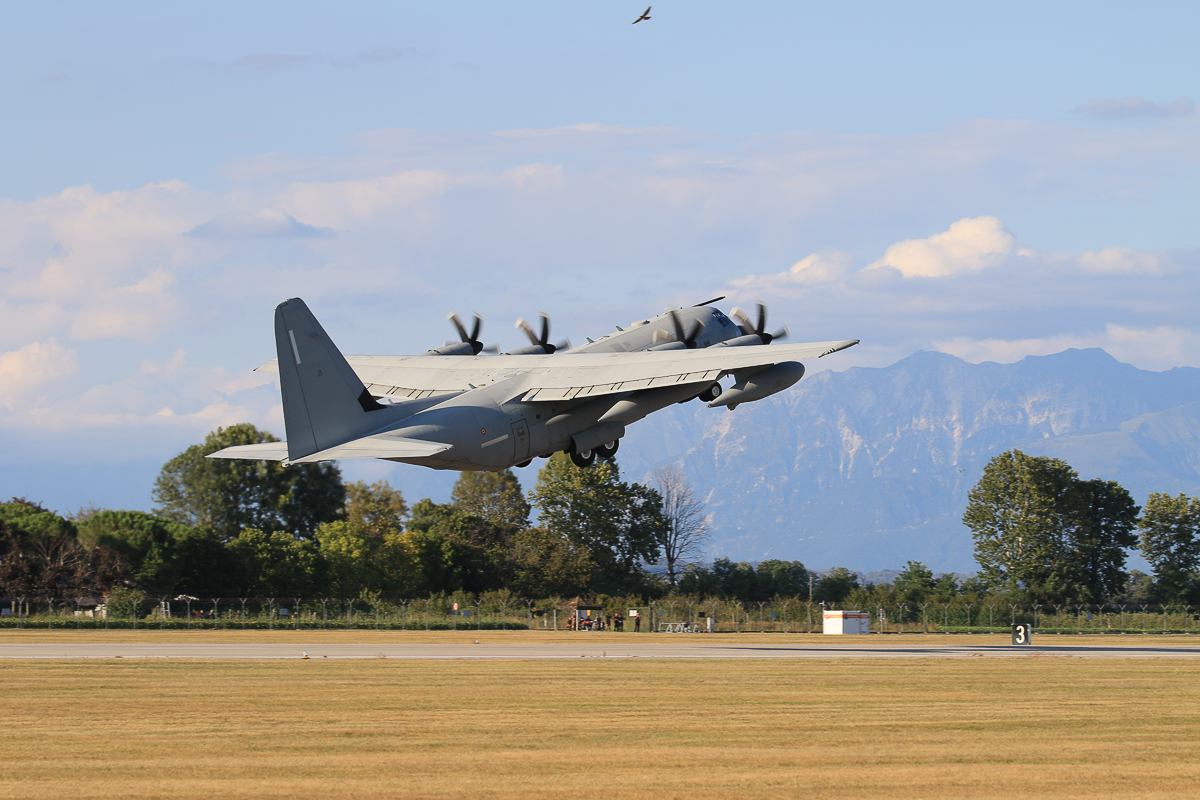
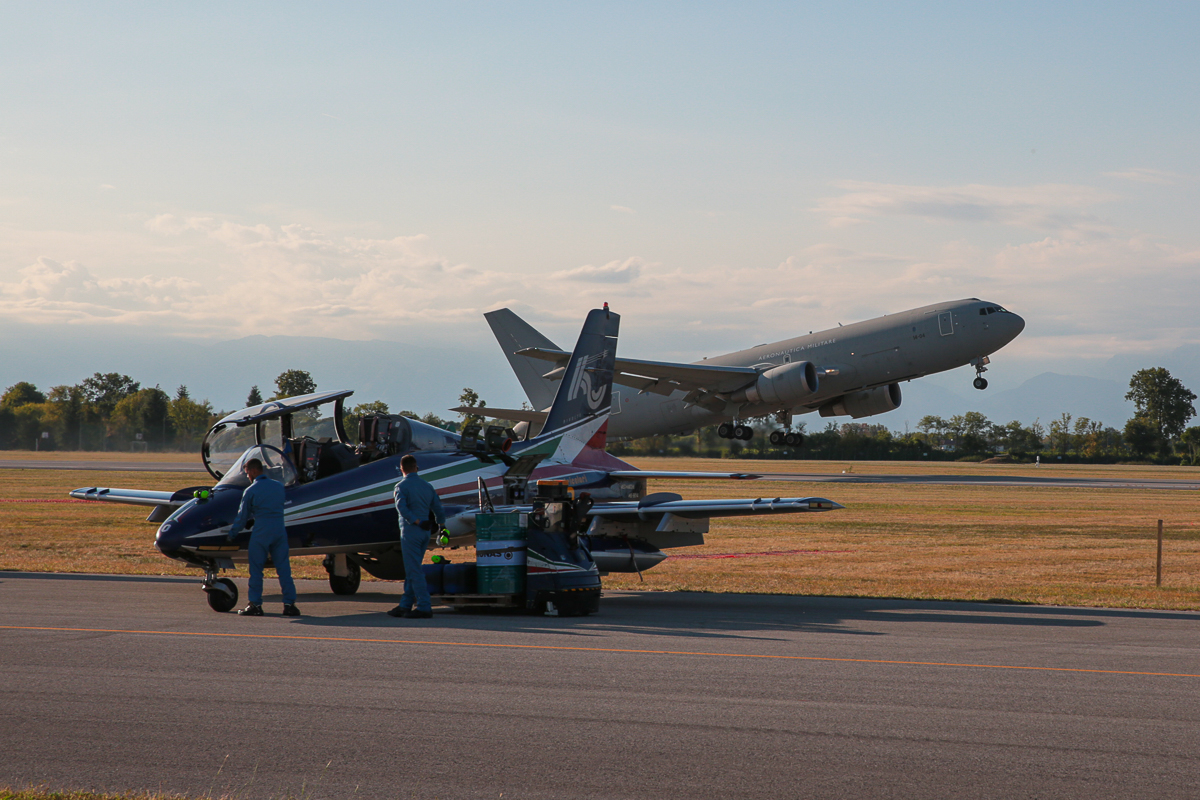
The second part has been more concerted: an F-35B (the first one delivered to ItAF and assigned to the 32nd Stormo in Amendola, which operates also the A version) has simulated a SEAD (Suppression Enemy Air Defense) attack, opening the weapons bay to show to the public two LGBs (laser guided bombs).

Immediately after other assets have entered the combat zone: a flight of F-2000A Typhoons (one of which was armed with two LGBs, to underline the swing role that the Typhoons can now play), an A-200C Tornado of the 6th Stormo, coming from Ghedi, and a flight of A-11B Ghibli (the nickname of the AMX) taken off from Rivolto, have performed several attacks against the simulated enemy area, clearing the way for two HH-101A Caesar helicopters of the 21st Gruppo, 9th Stormo, which, once landed, have disembarked eight units of special forces (from the 17th Stormo Incursori – Commandos Wing). During their time on the ground, the helicopters have been covered by the other aircraft providing Close Air Support.

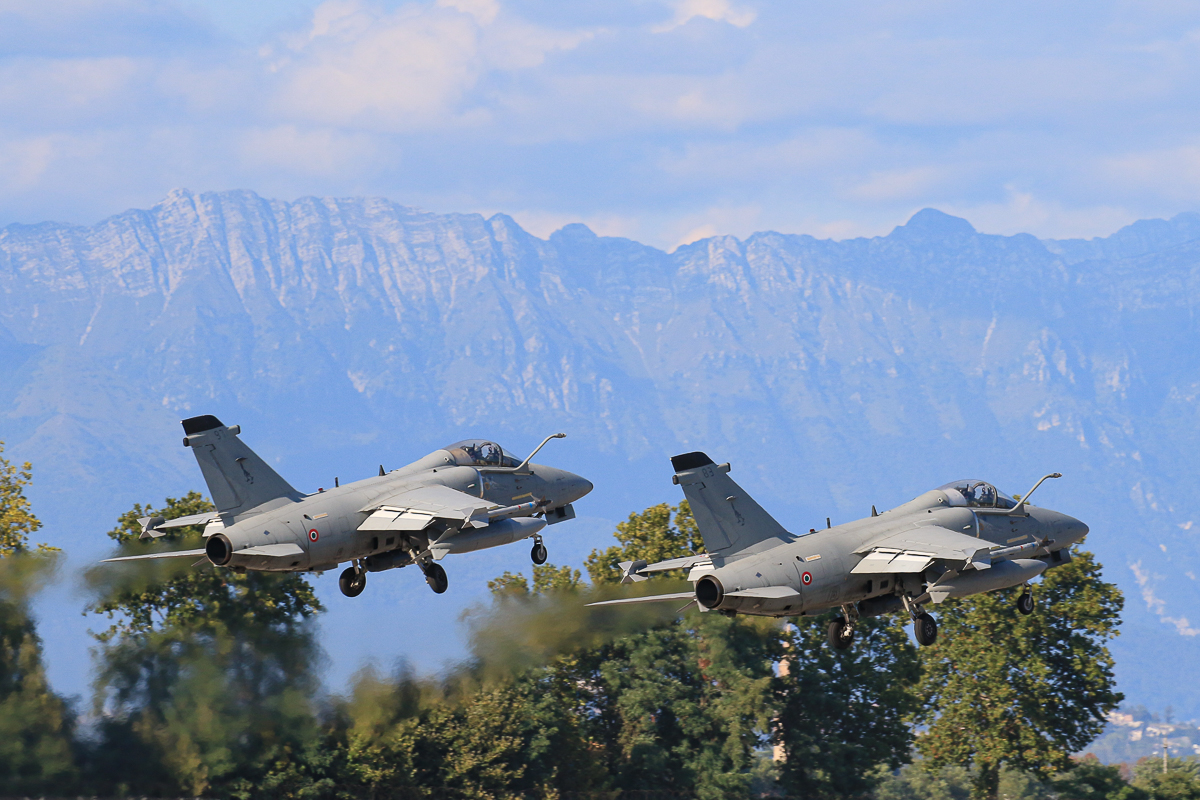

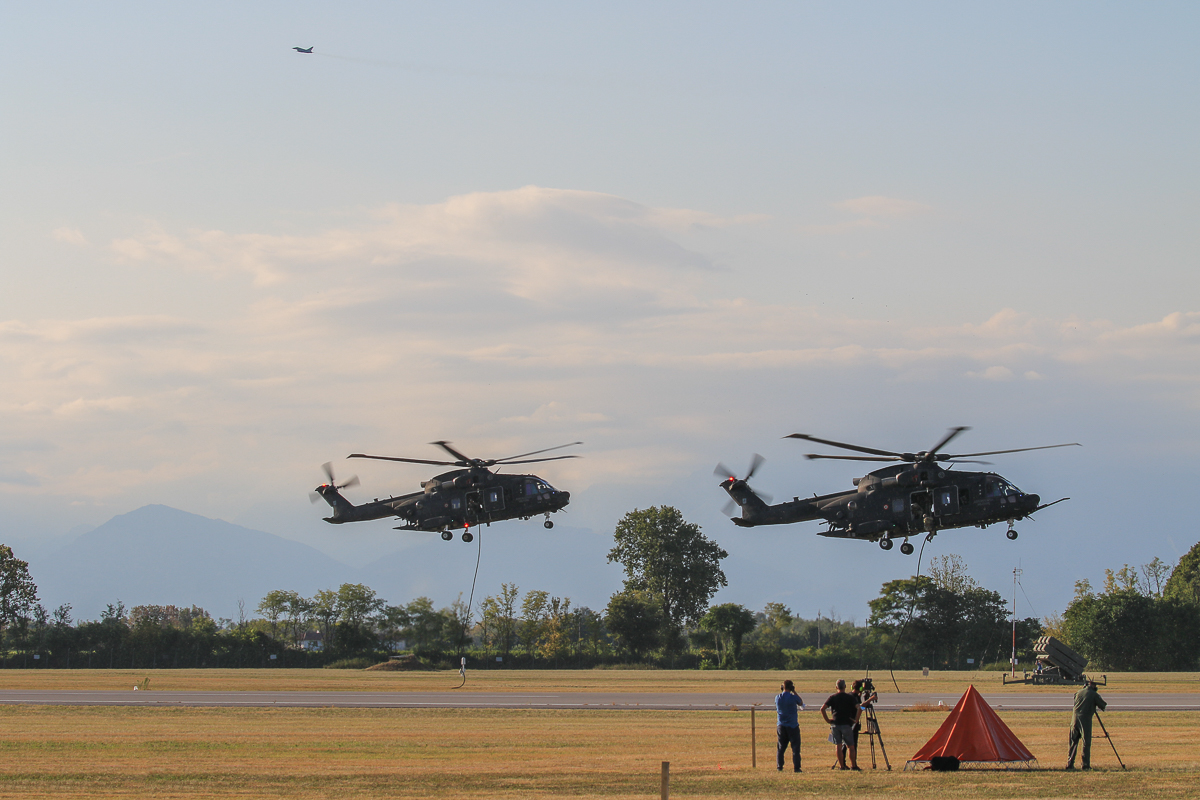
Once concluded this adrenaline-packed demonstration, the public has had the first chance to watch the STOVL (Short Take-Off and Vertical Landing) version of the Lightning flying. The F-35B has shown her fixed point hovering capabilities, as well as fast speed pass and a very short landing. Those who have attended the show on Sunday, partially spoiled by the rain, in return have seen a take-off on a wet runway that has been really stunning.
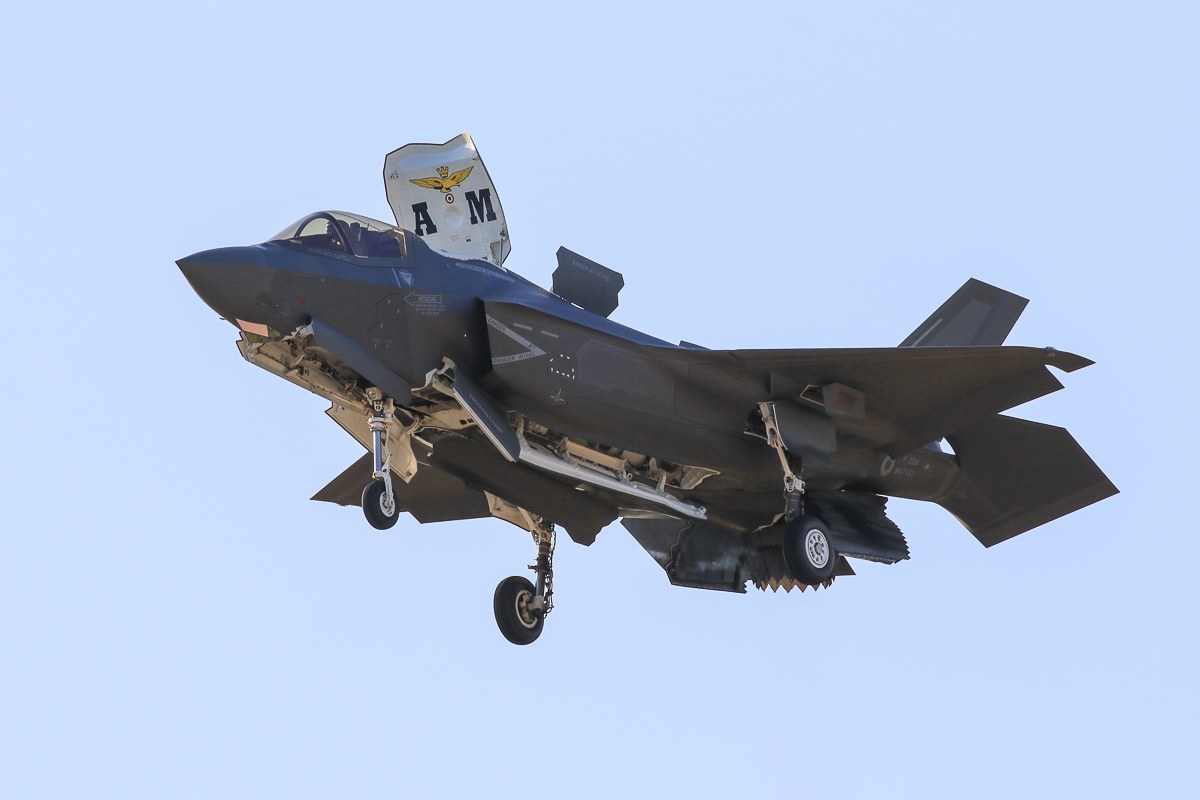
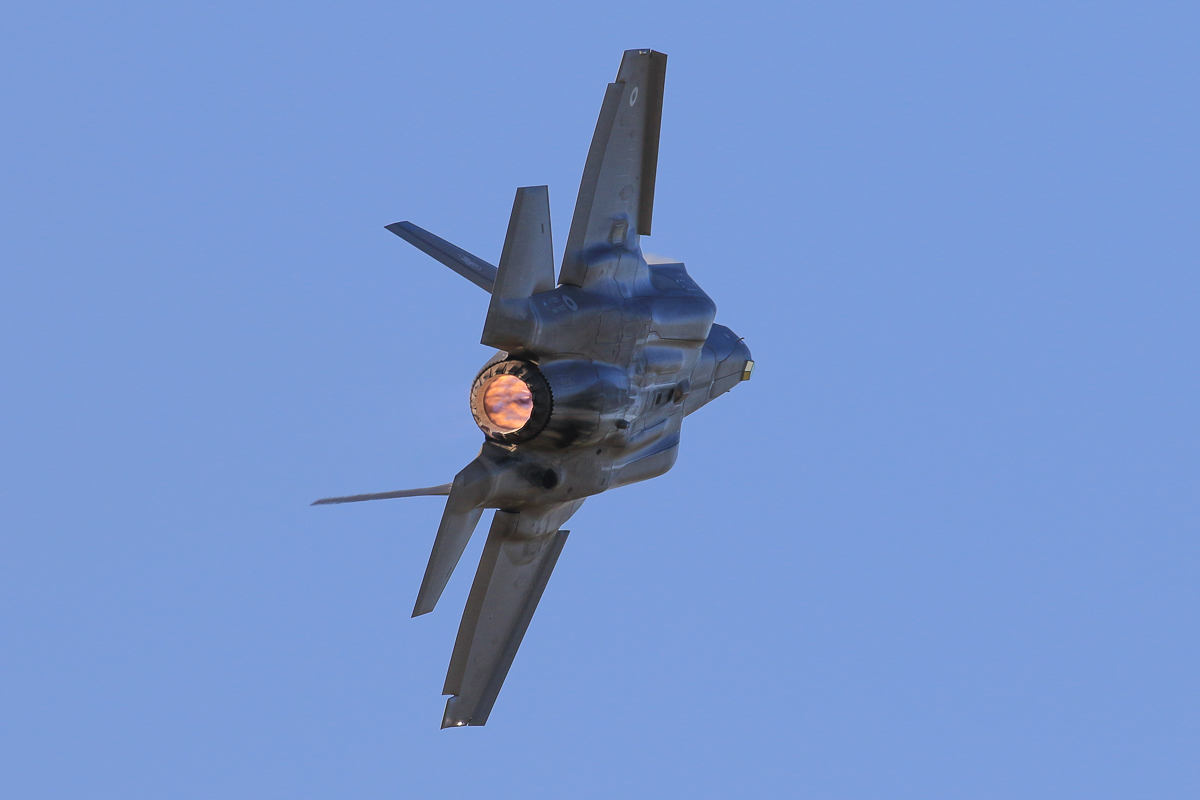
All the assets participating to the demonstration have overflown the runway, with the tanker in formation with the fighters, followed by the G-550 CAEW (assigned to the 14th Stormo), and the two transports safely behind them.
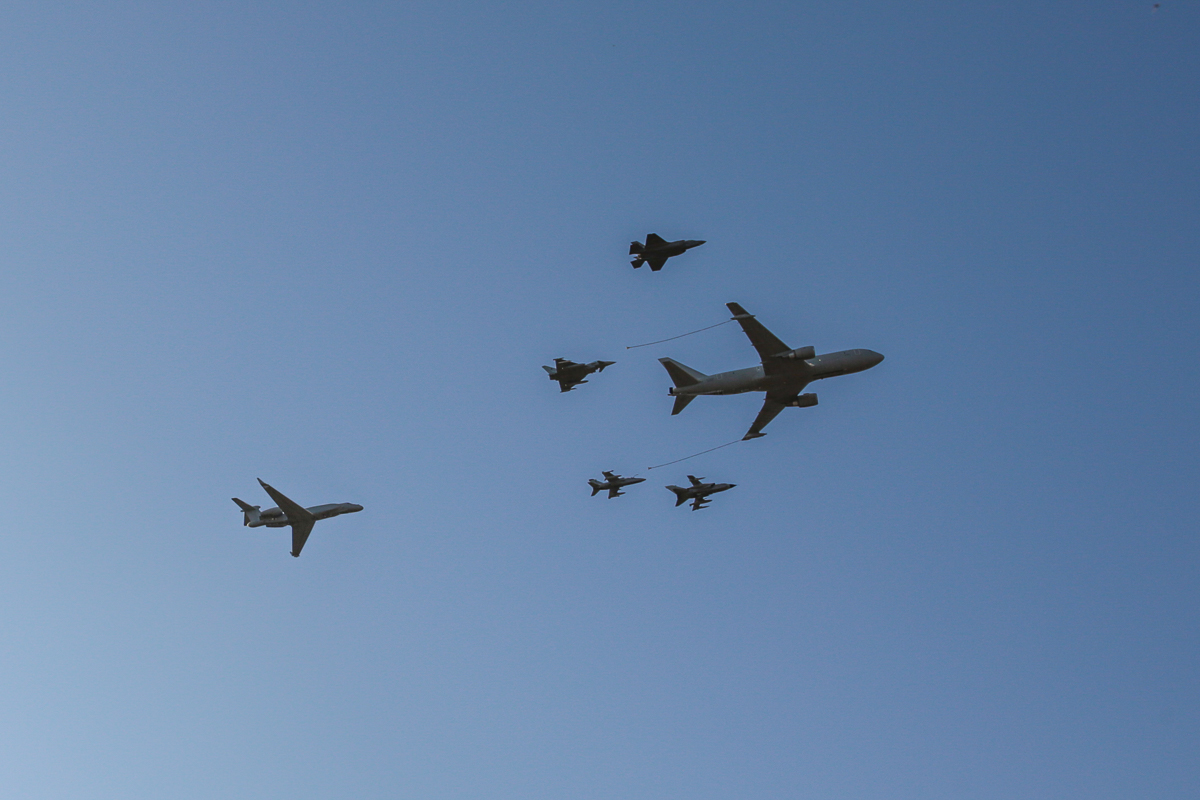

After such a dramatic performance don’t forget that this was the Frecce’s anniversary, so let’s go back to one of the best aerobatic team in the world; while the simulation was going on, the technicians and the pilots of the Pattuglia reached their aircraft to prepare for their display. The weather hasn’t changed, so they could present their complete programme. After the spectacular tricolor smoke test, the aircraft (remember that it is the only team that flies with ten airplanes) took off in two echelons and started the sequence of manouvers; one of the main features of the Frecce is that they never leave the sky over the airfield empty, because when the other nine aircraft regroup for the next figure, the solo pilot entertain the public with his unique signature manouvers (like the Volo Folle – Mad Flying, or the Lomçovak).
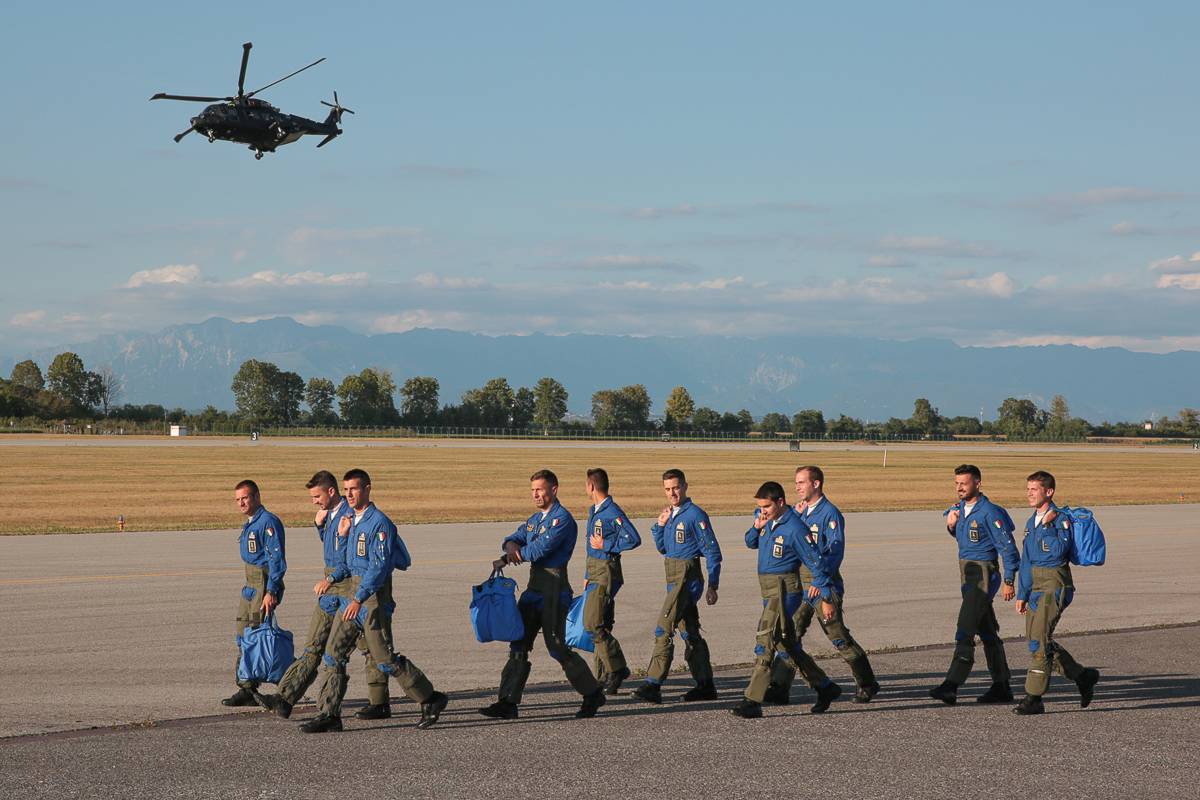
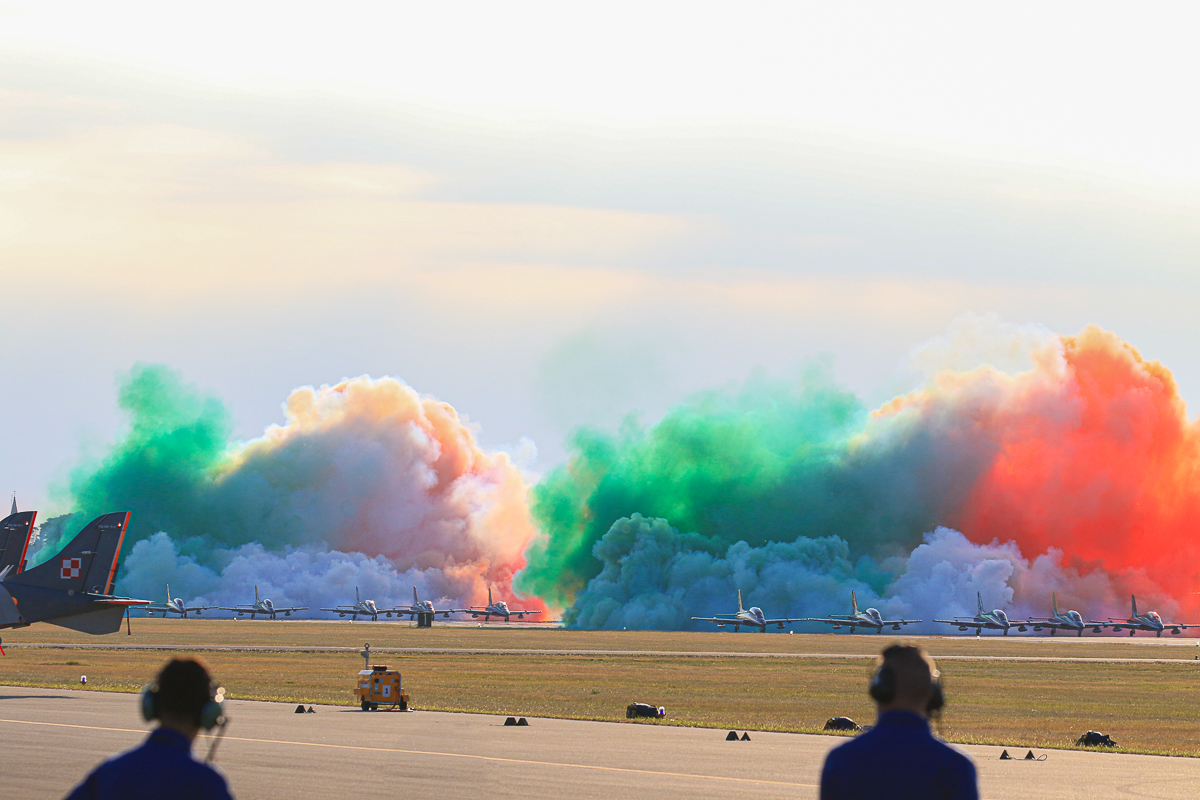
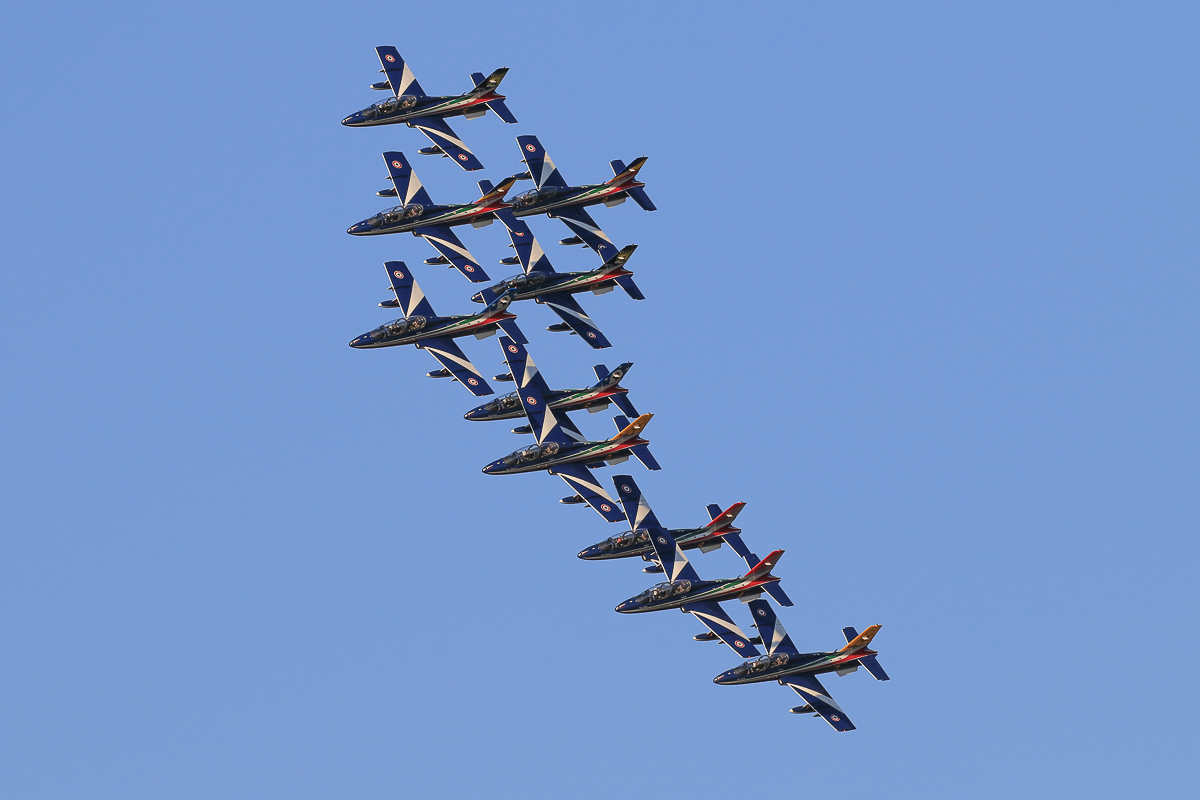

As always, the exhibition ends with the Alona (literally Big Wing), performed following the notes of “Nessun dorma”, the most famous aria of Puccini’s Turandot, performed by Luciano Pavarotti. And I can assure you that when the solo pilot inserts his plane in the white smoke trail of the other nine aircraft, and immediately his fellow pilots commute their smokes from white to green, white and red, spreading the longest tricolor in the world, it sends shivers down my spine, altough I have seen this scene dozens of times.
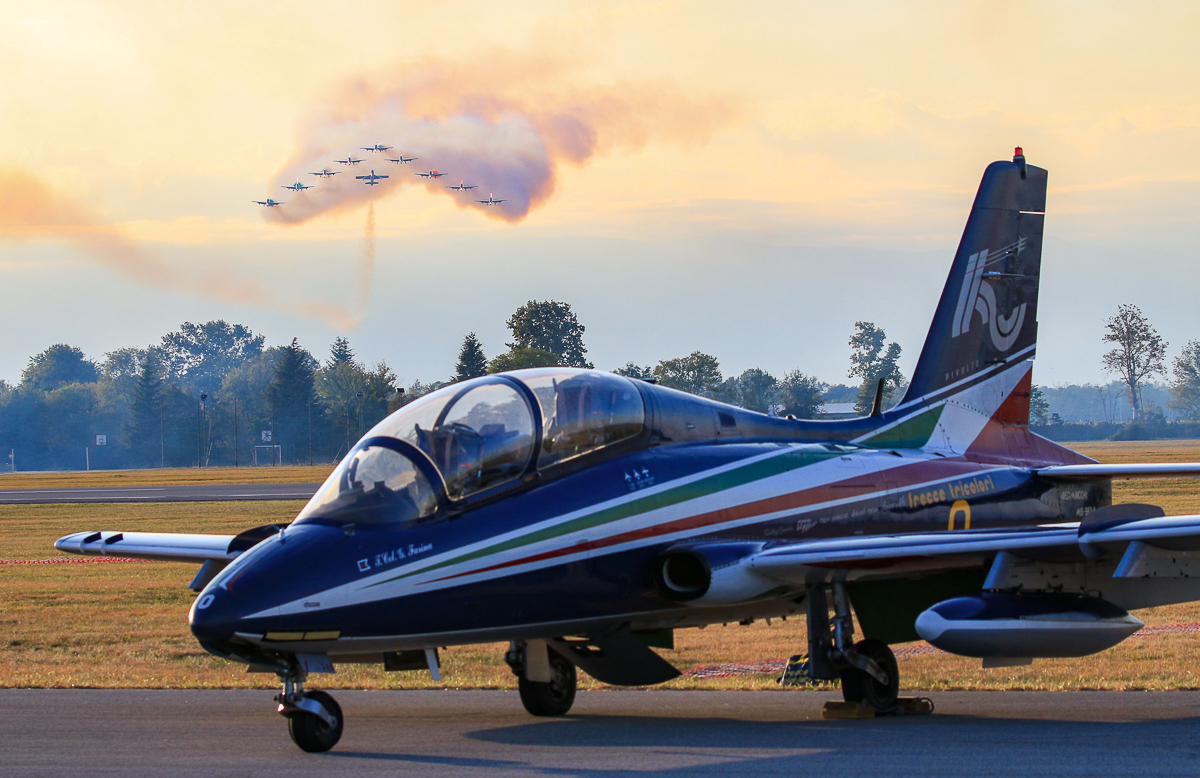
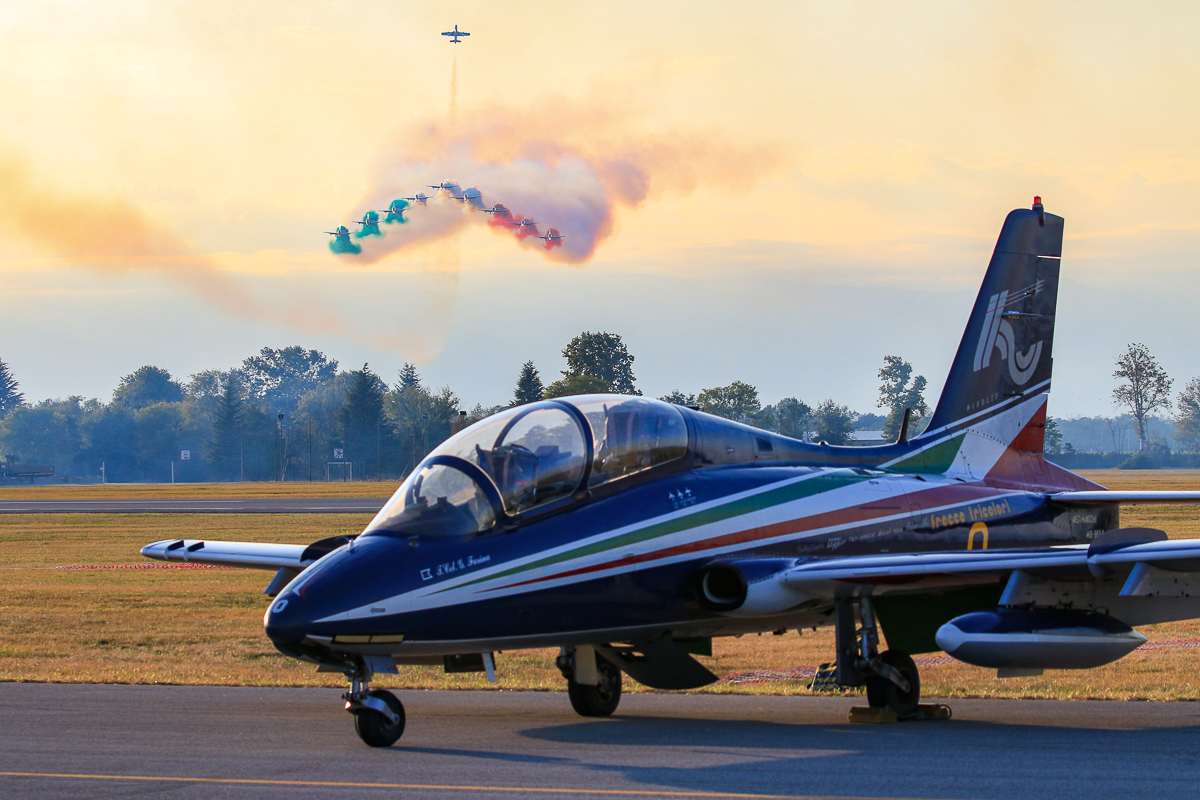

Once landed and parked their aircraft, the pilots have enjoyed the “hug” from the public, and have received the sincere and touched congratulations of President Mattarella, who has spent several minutes speaking with them and posing for the photo-ops with all the members of the Pattuglia.

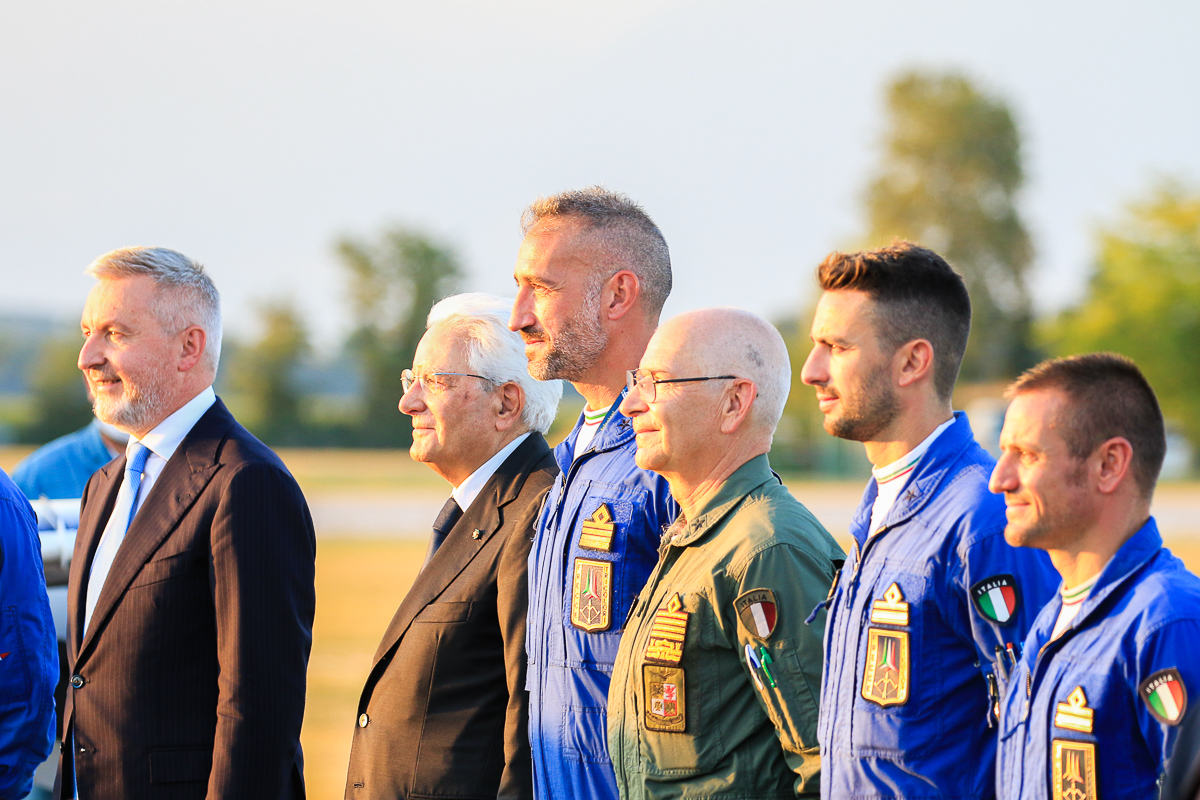
What else to say? Kudos to Aeronautica Militare, Frecce Tricolori and everyone involved in the massive effort needed to manage such an event in difficult times like the ones that we hope not to experience again. Our wish is that next year’s programme won’t have to register any cancellation, but I urge you to tie a string around your finger for 2023, when the Italian Air Force will celebrate her centenary; big surprises are in store for those that will attend, and be sure that I will!
Gabriele was born in Turin, Italy, grew up in Sicily and now lives in Rome. His love for aviation goes back to the days when he was seven years old, he started to collect the ‘History of Aviation’ sold weekly at the nearby newsstand. With that, he realized that his goal was to become a military pilot. This dream met a harsh reality when, during the medical tests, a defect in his chromatic sense of sight was discovered.
His interest in photography arose a few years later, when he bought from a colleague his first single-lens reflex camera, a Pentax ME Super. Then everyday life took its toll; working as an IT analyst, studying for an MD in political science and starting a family left no time for enjoying his old interest for aviation. One day in 2008, he decided to revive the passion, starting again to take pictures of aircraft each time he has a chance. Now, using Canon gear, he is striving to become a photojournalist.
Gabriele can be reached at: [email protected]


